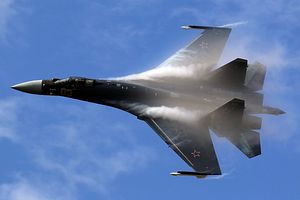Russia has offered China a second batch of Sukhoi Su-35S (NATO reporting name: Flanker-E) multirole fighter aircraft destined for service in the People’s Liberation Army Air Force (PLAAF), Russia’s Federal Service for Military-Technical Cooperation (FSVTS)
“We are expecting a response from China on our offer to purchase modern weapons and military equipment manufactured in Russia, including additional batches of Su-35 fighter jets,” the service said on the sidelines of the “Army-2019″ forum outside of Moscow. According to Chinese media reports, the PLAAF is considering the acquisition of additional Su-35 fighter aircraft.
The FSVTS confirmed in April that Russia completed the delivery of 24 Su-35s.
The first batch of four Su-35 fighter aircraft arrived at a flight training center of the PLAAF in Cangzhou City in Hebei province in northern China in December 2016. A second batch of 10 Su-35 fighter jets was delivered in December 2017. It is unclear when the last batch of 10 aircraft was delivered.
China’s Ministry of National Defense (MND) officially confirmed in April 2018 that the Su-35 had entered service with the PLAAF. “The following month, PLAAF Su-35s for the first time escorted an undisclosed number of Xian H-6K bombers and support aircraft during a long-range patrol over the Bashi channel and around the island of Taiwan on May 11,” I noted elsewhere.
China is first international customer of the Su-35. Beijing and Moscow signed a $2.5 billion contract for 24 aircraft in November 2015. Included in the sale is Russian ground support equipment and spare engines, the delivery of which is expected to be completed by 2020. The per-unit cost of a Su-35 is estimated at around $85 million. As I noted elsewhere:
The Su-35 is an upgraded fourth generation, twin-engine, multirole air superiority fighter aircraft powered by two AL-117S turbofan engines and fitted with thrust vectoring nozzles allowing the aircraft to attain “super maneuverability”.
Additionally, the aircraft features “an export-standard radar system — the Irbis-E passive-electronically scanned-array radar, capable of tracking up to 30 targets simultaneously and purportedly able to engage up to eight — an electronic warfare and communications suite, as well as a newly integrated receiver for the domestically-built BeiDou satellite navigation system. (…)
The PLAAF Su-35s can reportedly be armed with air-to-air and air-to-ground missiles, unguided rockets, guided bomb units and unguided bombs including the R-27 (AA-10 ‘Alamo’), R-73 (AA-11 ‘Archer’), RVV-family air-to-air missiles, as well as Kh-35E (AS-20 ‘Kayak’) anti-ship missiles.
Notably, the U.S. imposed sanctions on China for purchasing the Su-35s in breach of the congressionally mandated Countering America’s Adversaries Through Sanctions Act (CAATSA) in September 2018.
































